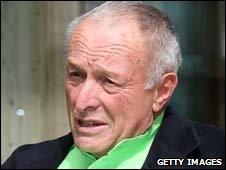Prince Charles's role in battle of Chelsea Barracks
- Published

The prince entertained the consort to the Emir of Qatar in April
The High Court has handed a partial victory to property developers CBC Group, who demanded compensation after plans to redevelop London's Chelsea Barracks were shelved. The firm blamed an intervention by Prince Charles for giving their partners, Qatari Diar, cold feet.
It's almost a quarter of a century since the Prince of Wales launched his outspoken attack on modern architecture, denouncing a proposed National Gallery extension as a "monstrous carbuncle".
There was little let-up in the years that followed. In 1987 Prince Charles said the Luftwaffe had done less damage to London than a scheme for Paternoster Square, next to St Paul's Cathedral. The project was designed by Lord Rogers, the architect at the centre of the Chelsea plans.
He said he "would go mad" if he had to work at Canary Wharf; Birmingham Central Library looked like "a place where books are incinerated, not kept" and in 2008 he said a £6m stainless steel lecture hall at Essex University looked "like a dustbin".
But now his role has been questioned in a high-profile court case which blamed him for the demise of a scheme for luxury apartments in one of the country's wealthiest areas.
The case saw property developers to the rich, the Candy brothers, accuse the Qatari royal family of dropping the £3bn plans for Chelsea Barracks in London only after the prince's intervention.
They sued the developers, state-backed Qatari Diar, for £81m they would have been paid had planning consent been achieved.
Mr Justice Vos found the Qatari partners had breached the terms of their agreement by withdrawing planning permission after the intervention of the Prince of Wales.
But the judge said the Candy company, CPC Group, was not entitled to a payout of £68.5m under the original contract, as its lawyers had claimed.
He said the developer was entitled to damages, but did not immediately award a sum because CPC had not formally applied for them. He said the issue could be considered at a later hearing if the developer chose to pursue it.
Ahead of the case, Lord Rogers, who designed the development, said the prince's actions were "unconstitutional" and called for a panel of experts to examine his misuse of power.
Afterwards, Ruth Reed, of the Royal Institute of British Architects, agreed that the prince's intervention was "an abuse of a privileged position".
"It will affect the way that external investors view developing in London in future, and will inhibit people within the city from innovating in terms of architecture," she said.
'Heart sank'
The prince's objection to the modernist steel and glass design was expressed in a letter which was described in court as "a hand grenade".
He told the Qatari prime minister, also chair of Qatari Diar, that his "heart sank" when he saw the design and he attached a scheme by a classical architect he preferred.
At the High Court, Mr Justice Vos was told that Prince Charles and Lord Rogers "had previously crossed swords" and his opposition to modern architecture was "notorious".

The wealth of Nick Candy and his brother is estimated at £330m
The prince's determination to quash the project was revealed in an account of a phone call with his private secretary Sir Michael Peat, whose attitude was described as "hostile". He said the prince "would fight this to the finish" and make his objections public unless it were changed.
There was also a suggestion the prince was trying to exert some political pressure, with the mention of a meeting with officials at the Greater London Authority.
But it seems a meeting with the Emir of Qatar over tea at Clarence House in May 2009 finally led to the scheme's failure a month later.
Sir Michael noted the emir also disliked the design, but one of Christian Candy's Qatari Diar colleagues put it a little more bluntly, saying "the Prince of Wales pissed in his ear about how awful the scheme was".
Mr Candy described the conversation in an e-mail, saying the emir "went mental" at the head of the company, describing the design as "awful" and demanding it be withdrawn.
'Royal favour'
Mr Candy, who arrived at court in a Rolls-Royce, said after Prince Charles sent his letter he feared the company might withdraw "as a favour from one royal to another".
In court, the chief executive of Qatari Diar denied he had been put under political pressure to withdraw the plans. The company argued the plans were already doomed to fail to secure planning permission.
But evidence from the prince which emerged after the judge had retired to consider his verdict shone a new light on the company's mindset.
Lawyers for Mr Candy claimed that a senior Qatari Diar employee, John Ward, deleted a series of e-mails which made reference to Prince Charles or Sir Michael Peat from the company's Doha computer server.
But Qatari Diar's barrister, Joe Smouha QC, said those allegations were "entirely unjustified". The e-mails were later recovered from another server.
They showed that the company was extremely concerned about the impact of the prince's intervention, with one e-mail from its chief operating officer saying it "could be seen as a major embarrassment to Qatar".
The same e-mail reveals fears that the affair could undermine UK government support for projects, as Qatar had a "major financial interest" in the UK.
Another suggests the prince had made personal representations to the deputy mayor of London, Sir Simon Milton - who has responsibility for planning.
Minutes from a later meeting quote Sir Michael Peat as saying the prince wanted to "assist his friends in Qatar and avoid criticism of them which he feared would stem from imposing a scheme which was not popular".
He also revealed the prince was "very unhappy" the matter had been made public.
The reconvened court was told the e-mails were deleted to cover up the emir and the prince's "key" involvement in the decision. Lord Grabiner for the Candy brothers said the company's witnesses had lied when they suggested it was due to other reasons.
The Candy brothers' consortium bought the barracks site for £969m from the Ministry of Defence, hoping to boost their portfolio which includes One Hyde Park, boasting flats worth £100m.
The Sunday Times Rich List valued the socialite pair at £330m in 2009, a property empire built from a £6,000 loan used to develop a flat in Earls Court.
Now based in Monaco where they own two yachts, Christian, 35, is engaged to former It girl Emily Crompton, while Nick, 37, dates Australian pop star and actress Holly Valance.
'Inappropriate pressure'
When the barracks scheme was dropped in May 2009, Lord Rogers called for a review of the prince's powers, saying he had broken a constitutional understanding.
He told the BBC: "If we are to avoid a dangerous political clash then we need someone to solve the problem at a level which is not about this site, but at the level of royalty and their say in political matters."
Commenting on the High Court ruling on the case, Lord Rogers said the way the prince had intervened was "wrong".
"I hope that this judgement demonstrates that similar interventions should be considered far more seriously before they are made in the future," he added.
The president of the Royal Institute of British Architects (Riba) said after hearing the court evidence it appeared the prince had brought "inappropriate pressure" on the planning process.
"Behind-the-scenes influence would have been a huge hurdle to consider. No individual should use their position in public life to influence a democratic process such as planning," Ruth Reed said.

Lord Rogers designed the Millennium Dome and Paris's Pompidou Centre
Clarence House declined to comment on the outcome of the court case, but spokesman, Paddy Haverson, told the BBC the prince had "every right to express an opinion" and he did so "with passion, because he cares".
And certainly, this case is unlikely to mark the end of the prince's involvement in architecture.
The prince has an educational charity called the Foundation for the Built Environment, which aims to teach and promote a "timeless and ecological approach" to planning, design and building.
His development Poundbury, in Dorset, is a prime example of his values, put forward in his 1989 book, A Vision of Britain, combining traditional design with modern town planning.
Established in 1998, the foundation now works on about 25 projects a year in the UK and abroad.
It now also has a commercial wing called PF Urban which takes on commissions and channels any profit back into the charity.
A spokesman for the prince said he hoped that PF Urban would help more communities to create "thriving, healthy and prosperous places" in which to live.
- Published25 June 2010